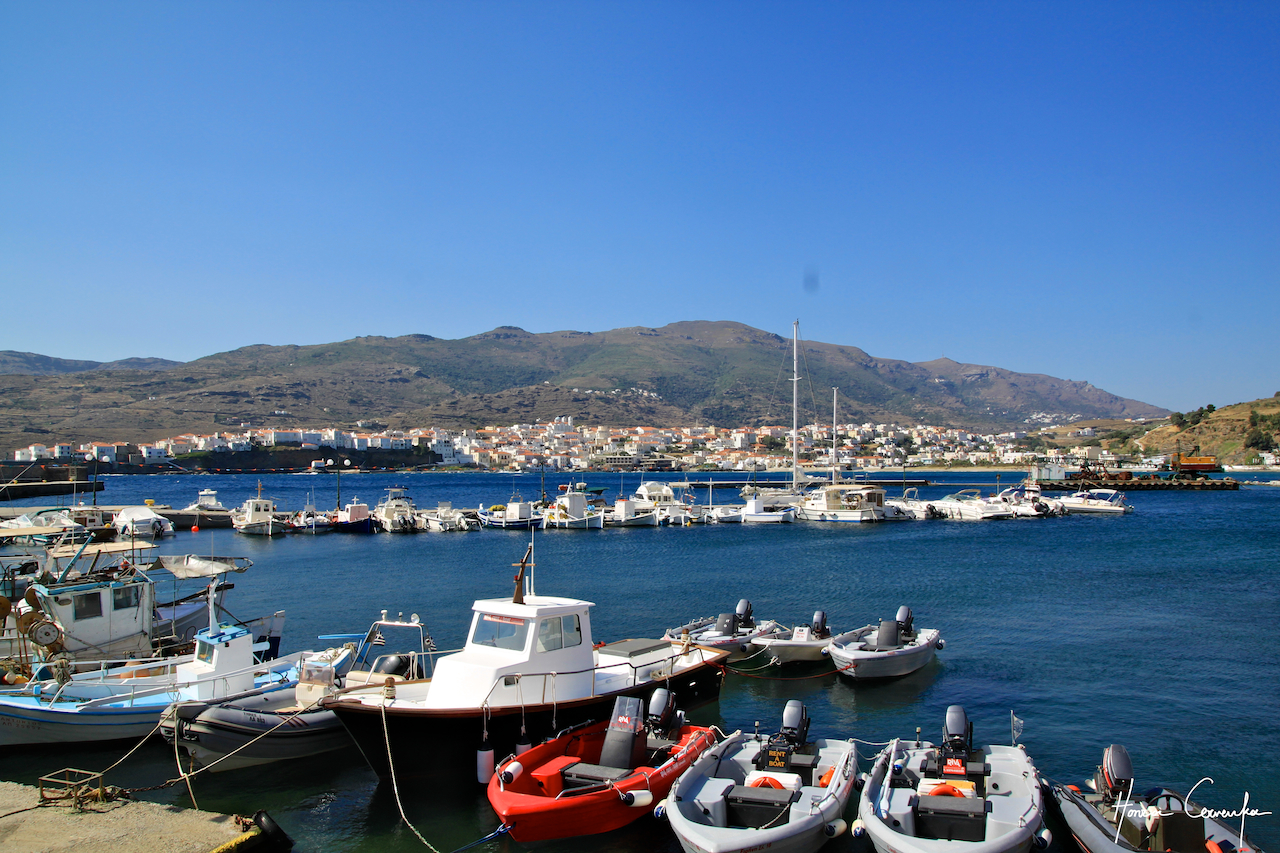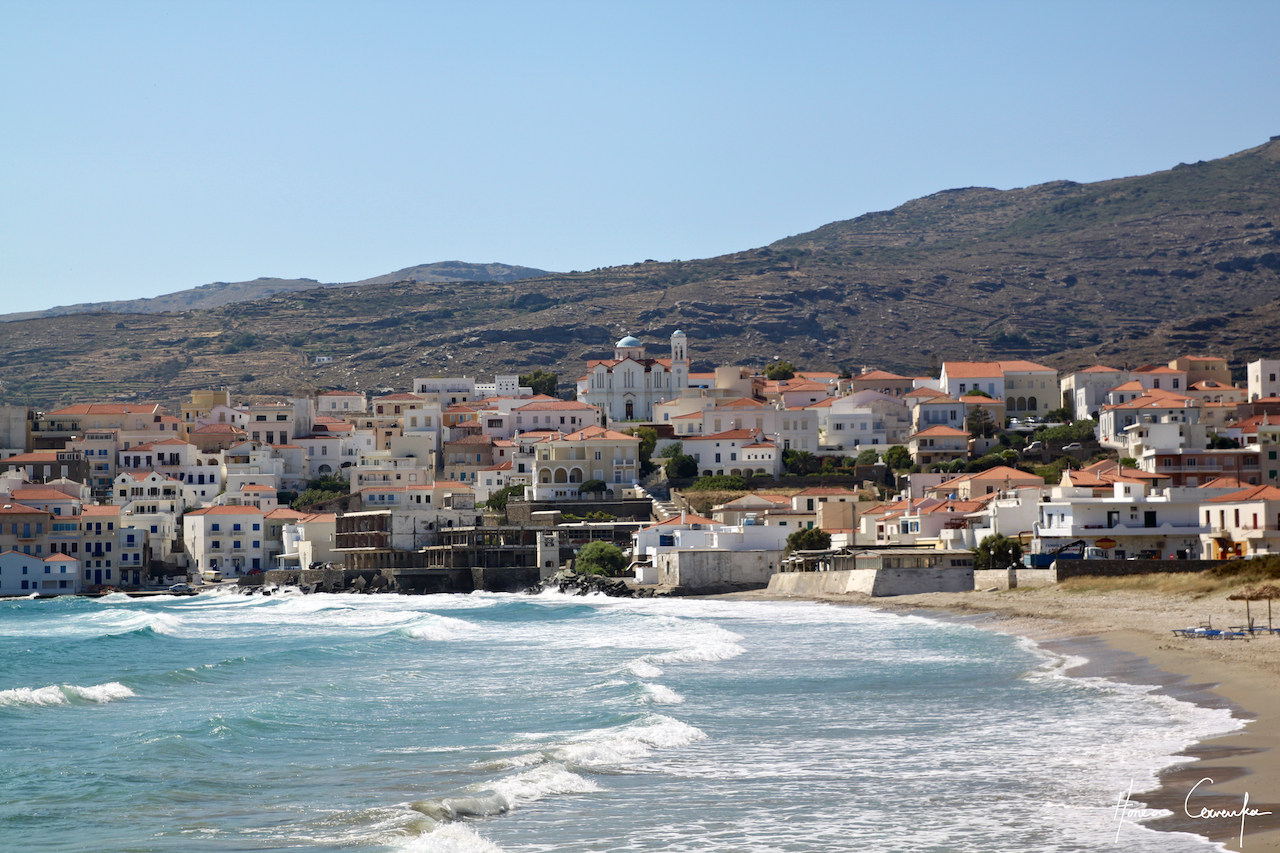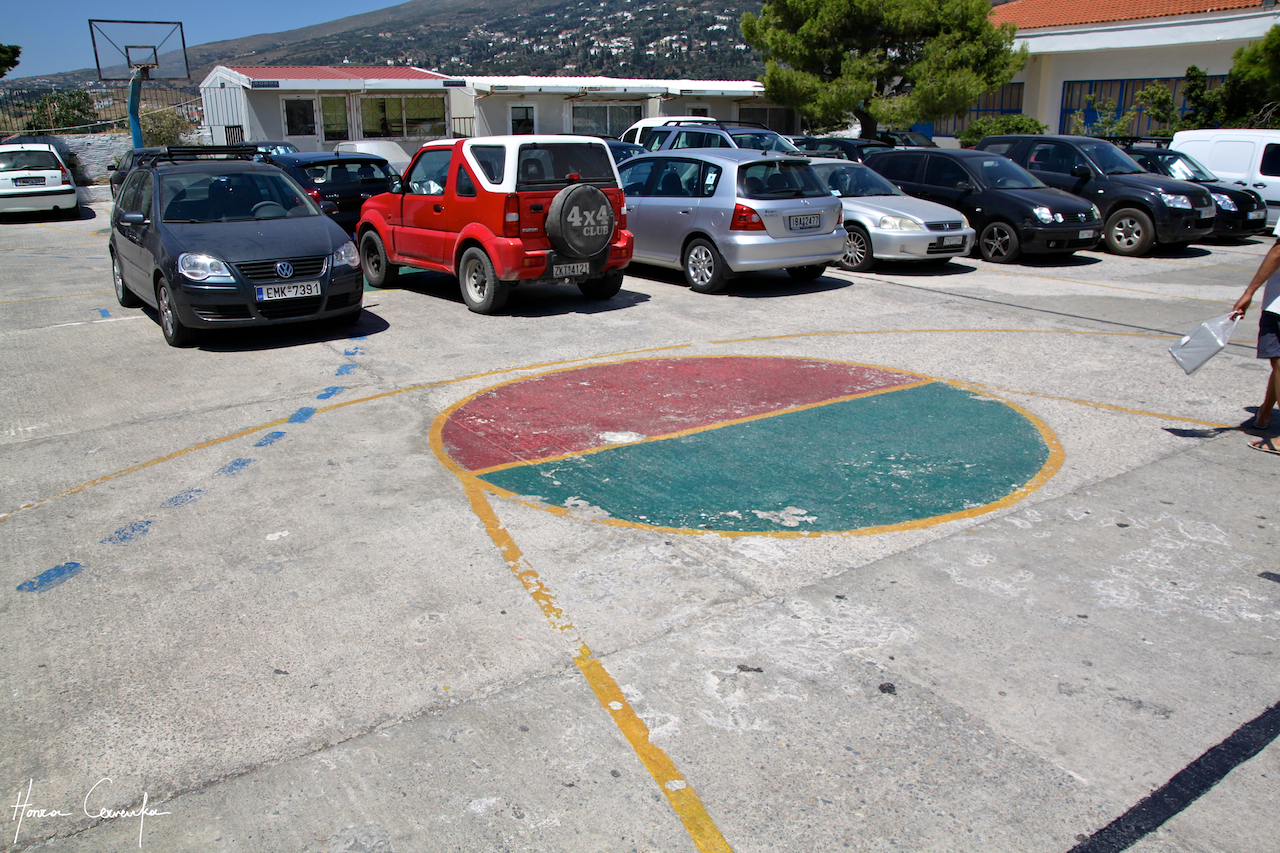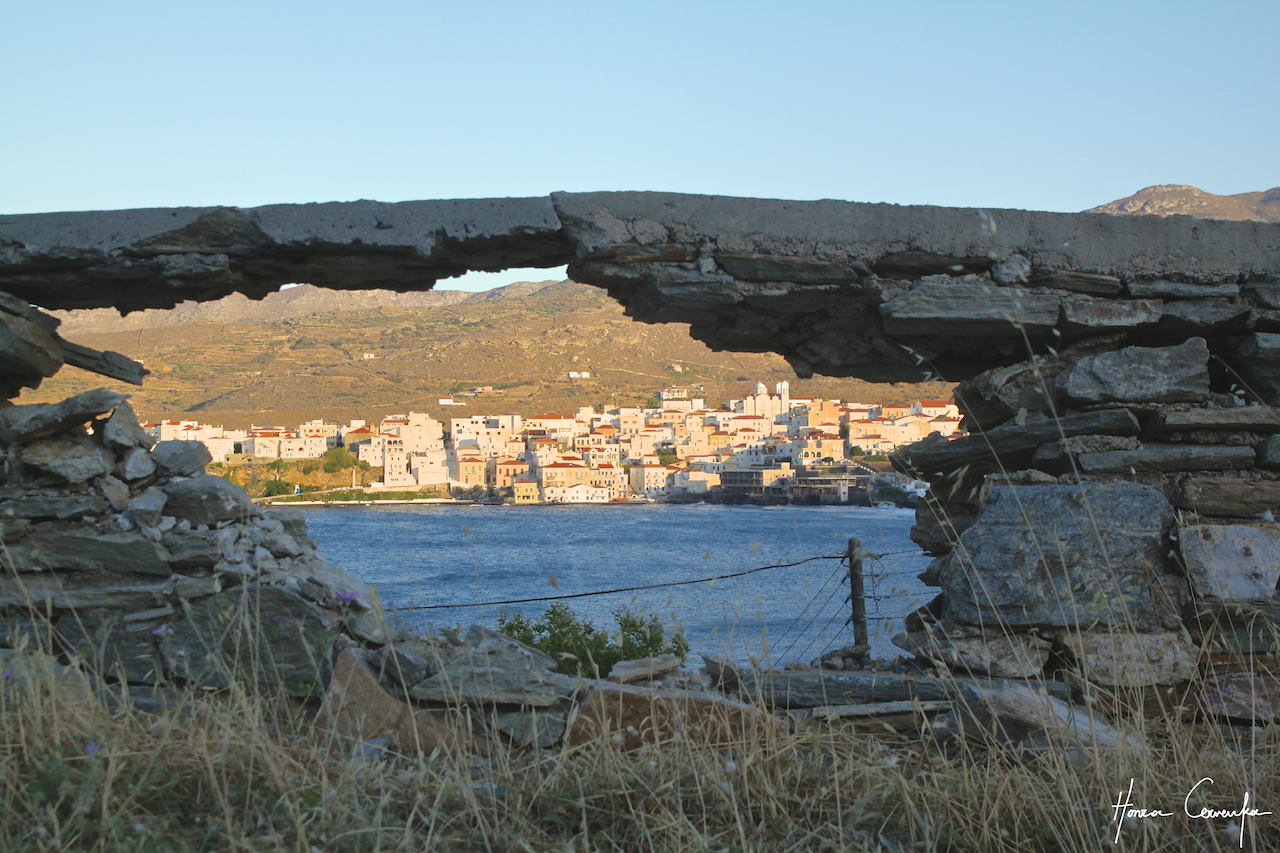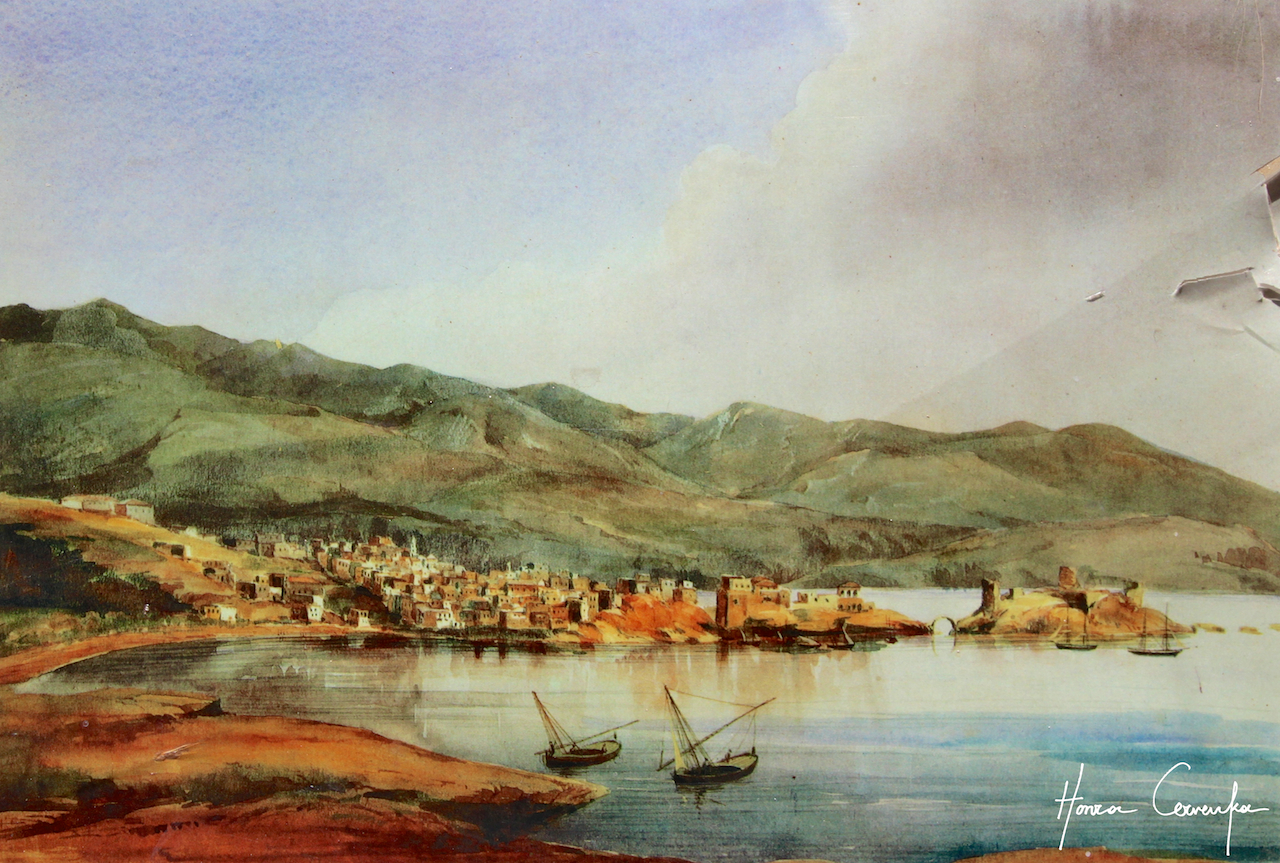The sixth day of our Sailing Odyssey was in fact sailing-less; we decided to spend the whole day in Andros and explore the nearby town of Kastron. The good news for you is that there will be tons of pictures in this post! You will recall from my previous post that we arrived here at night and initially moored stern-to, but the first thing we did in the morning was to re-moor, this time sideways. All in all, this took us about 40 minutes. I do not recall now what the reason behind the manoeuvre was, but, as with all things that have to do with mooring, the direction and strength of the wind must have been the decisive factor. Once safely affixed, we had a quick breakfast and went to the Kastron, which was a short walk from the port.
View of Kastron from the port
An abandoned bar (or maybe a tavern) at the harbour.
The harbour was being expanded--but in Greek style = no rush. The workers showed up at about 2pm.
The town quickly became my favourite so far and, looking back, it still remains in the top three for the whole trip. It was very picturesque, with many small alleys but also a bustling main street--boulevard even by Greek island standards. There was free public wifi in the town square, so Maurizio and I spent about an hour or so working on figuring out the ferry schedule for my dad and Lisa, Maurizio's friend, who were to join us soon.
Kastron
Close-up on the church
Close-up on the close-up on the church (although technically this is its other side, so I am cheating here a little with my descriptions).
Life's hard when you're in Greece
As you can see in the pictures above, the whole town is built on a small hill (most towns on Greek islands are; both for defence purposes and because, well, the islands are just hilly). On the top of the hill there wasa former elementary school where you could still find testaments to the area's juvenile past among its contemporary surroundings: a trashy mural and an basketball court turned into a vehicular obstacle course.
The real charms of Andros are the Venetian fort with its bridge, both in ruins. They are remnants of the Venetian rule of the island, which lasted from 1207 to 1556 AD, when it was conquered by the Turks. The complex is on a small island just off the coast (hence the bridge). They are fully exposed to the wind--still, and always, the Meltemi--and so we had to hold on to our caps (or at least I did, Maurizio was bronzed enough to handle the Greek sun 24/7 and wasn't wearing any):
The two "lampposts" that you see are actually remnants of old cranes. In the winter, when the Meltemi subsides significantly (to the point of being virtually non-existent), the sea is calm enough for small boats to pass under the bridge and unload. I cannot imagine it has been used in the past few centuries, but there it is. In the summer, however, the passage would have been suicidal--any ship would end up on the rocks with these waves.
The bridge was sadly closed to the public--I mean who wouldn't want to walk across?
We decided to go back up the hill to the centre of the town, where we walked around a bit more. We soon discovered a narrow, windy alley going down the hill again. The alley seems to have been made, at least in part, from remnants of old fortifications. You can see it quite clearly on the picture below--we joined the alley somewhere top-right, walked behind the stone walls (it was in fact a bit of a tunnel, as if through the foundations of the white houses on the top) and descended on the staircase that begins top-left:
Once down, we decided we had enough of yo-yoing up and down the hill and walked back to our ship. But, lo and behold, we found a stream of fresh water! This was most unlikely, especially in the middle of summer, since almost all Greek islands are very dry and without a natural source of water. In fact, most all islands receive regular shipments (literally) of tankers filled with water from the mainland. But this was not the case for Andros, which, it turns out, is one of Greece's greenest islands! We walked upstream for a bit and after just a minute or so, our surroundings looked nothing like what we'd seen prior on this trip. It is interesting how fast our brains get used to their surroundings--so far mostly dry, sun-beated islands--only to be shaken by a sudden change of scenery. In fact, Andros is famous for its springs in the whole of Greece--there is even a brand of bottled water from Andros sold nationally. According to legend, when the festivals in honour of Dionysus occured each summer, the springs ran with wine rather than water, but we clearly missed the party.
After we walked back to the beach, we found a flock of kids taking their training sailboats--much like the "laser" boats that I trained on years ago in Duino--to sea. According to Maurizio they were actually quite skilled. Upon returning to the boat, I took a shower and did laundry (read: rinsed clothes with water and shampoo--we were sailors after all!) and Maurizio went for a swim. In the evening, after a well-deserved nap, we went uphill, but on the other side, away from the town, to the hills separating our bay from the one further north. On the top, we found a church, a tomb and an obelisk. The sun started to set, but we still got magnificent views of Kastron.
View of Kastron from the hill: On centre-left you can see the Venetian fort and the bridge leading to it, on centre-bottom you can see our harbour: The sailboat with masts is our very own Oxalis.
View of the harbour (pardon the quality--iPhone 4S only goes that far): On the left you can see a power plant (more about that below) and in the centre you can see our ship moored at the pier.
Once our brains could not handle the serenity of the view any longer, we walked back to the ship to have dinner, and then went back into town.
The harbour we were moored in was actually built right next to a petrol power plant (as you can see above). However, there was virtually no noise coming from it and so we suspected it had closed down. We peeked in and a nearby security guard confirmed the suspicions; the plant had indeed closed 7 years ago. Now, usually, when you encounter a security guard whilst peeking into a place were you have absolutely no business peeking into, you get kicked out. But this is Greece, so the security guard actually gave us a little tour of the place. Inside the main hall, there were 6 huge engines with 12 pistons each made by Grandi Motori in Trieste, |taly--a stone's throw from where I once lived! Maurizio told me that the Grandi Motori engines were world-renowned for their excellent quality and durability. The firm still exists, but is now a subsidiary of its once-chief competitor from Finland; it continues to make engines for worlds biggest ships; in fact, it made the worlds biggest engine some time ago.
Inside of the disused power plant. iPhone 4S is again to blame for quality...
The eventful day was concluded by a wonderfully uneventful walk through Kastron in the evening. It was filled with the usual mix of gelato and emails, but this time also spiced by a lovely Skype session with my Minnesotan family.
Remained moored in Kastron, no distance sailed. See map for the route sailed during the Odyssey and click here for more posts from the Greek Sailing Odyssey.
Picture of Kastron on an old postcard--you can see the Venetian fort already in ruins
And I saved the best for last--there was a lighthouse off the little islet with the Venetian fort. Combine strong Meltemi with a rough sea, add a lighthouse on the smallest rock imaginable and you get this spectacular challenger of nature.
And here is some lighthouse-real-estate competition, but we all know who the winner is here...
